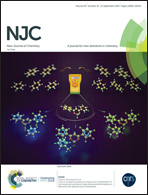A comprehensive DFT study on the sensing abilities of cyclic oligothiophenes (nCTs)†
Abstract
Linear conducting polymers are extensively studied as sensors for various analytes, whereas studies on cyclic analogues are limited. In this study, sensor applications of cyclic oligothiophenes (nCTs) have been explored by means of DFT (density functional theory) calculations. Three models, namely, five (5CT)-, six (6CT)- and seven (7CT)-membered cyclic oligothiophenes are evaluated against twelve different gaseous analytes. For optimization of geometries and interaction energies, the B3LYP method including Grimme's dispersion correction (B3LYP-D3) was applied with the 6-31++G(d,p) basis set. Chemical interactions of nCTs with NH3, CO, CO2, N2H4, HCN, H2O2, H2S, CH4, CH3OH, SO2, SO3 and H2O analytes are analyzed via interaction energies, Gibbs free energies, electronic properties and UV-Vis analysis. The interaction energies are quantitatively correlated with the volume of the cyclic oligothiophene (nCT). The electronic properties are calculated at the widely accepted B3LYP/6-31G(d) level of theory; however, the TD-B3LYP/6-31G(d) method is used for the UV-Vis analysis. Symmetry-adapted perturbation theory reveals that the 5CT system is highly sensitive towards analytes as compared to the 6CT and 7CT systems. This assumption is also strengthened by the HOMO–LUMO gaps and excited state properties. ESAPT, HOMO–LUMO gaps, NCI, and NBO charge transfer suggest that nCTs are highly sensitive towards SO3 followed by SO2. The density of state spectra shows the reasonable variation in the peaks of nCTs upon interaction with SO2 and SO3 analytes. The findings of this study suggest that cyclic oligothiophenes can effectively be used for the rational design of atmospheric sensors, which are superior to the conventional sensors.



 Please wait while we load your content...
Please wait while we load your content...